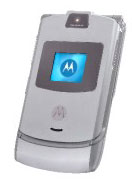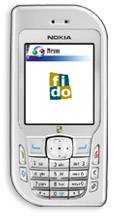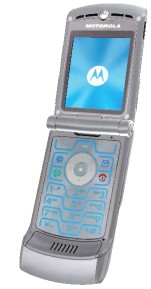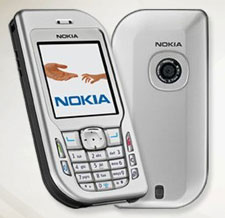 New
Cell Phones Get Svelte, and Stuffed
New
Cell Phones Get Svelte, and Stuffed
By Jim Bray
Cell phone technology continues to advance, meaning consumers are being offered
more features for less money and in smaller packages than ever before.
Part of this is the continual march of technology, while another part is “the
Gillette syndrome,” by which the hardware is offered affordably so that
the software (in this case, airtime and other features) can be sold on a month-to-month
basis.
I recently got to play with two new model cell phones, representative samples
of the species, and came away with two wildly different impressions. These
are only my impressions, of course; yours may be completely different.
The first phone was the extremely nifty Razr V3 from Motorola, which is the
thinnest cell phone I’ve seen – and that alone makes it a conversation
piece. I really mean that last part, too; I was in a, well a bar, with a friend
and the Razr was sitting on the table in front of me, which caused a server
to make a special trip over to our table to ask about the phone. It was so
thin she didn’t think it was a phone and, once that bit of knowledge
was imparted, she asked for a closer look at what was the neatest phone she’d
seen.
Who’d have thought a phone could be a babe magnet?
The second phone, which I tried immediately afterward, was the Nokia 6670.
This model blends cell phone with PDA, which I discovered was a case of severe
overkill that took away any joy I might have had in using the phone. I’m
sure there are many who’ll find it the greatest communications device
since tin cans on a string, but not me. But more about it later.
 The
Motorola Razr isn’t just ultra-thin; it’s also crammed full of
advanced features such as MPEG4 video playback, Bluetooth wireless technology,
a digital camera and more. And though I found its “precision-cut keypad” a
bit poorly labelled (which is a complaint I regularly make against today’s
cell phones), it was still quite easy to use.
The
Motorola Razr isn’t just ultra-thin; it’s also crammed full of
advanced features such as MPEG4 video playback, Bluetooth wireless technology,
a digital camera and more. And though I found its “precision-cut keypad” a
bit poorly labelled (which is a complaint I regularly make against today’s
cell phones), it was still quite easy to use.
The keypad reminded me of the remote control for an old Mitsubishi television
I had about 20 years ago – which was to this day my favorite remote
for its minimalist flat and metallic styling and finish. It was not only classy
looking, it worked very well
– though the flat metal keys were difficult to use strictly by feel.
The V3 shares that caveat, but unlike that remote control the V3’s keypad
lights up and that made it okay by me.
The V3 comes with a 176 x 220 pixel, up to 260K TFT color monitor that can
display up to nine lines of text. I couldn’t care a whit about text
messaging, but if you do this phone should do a good job of it.
And if you subscribe to call display, you can get a look at who’s inflicting
themselves upon your space, in color, without having to open the phone thanks
to a small external display on the unit. That’s quite handy when you
want to ignore certain people.
The Razr V3 gave me my first opportunity to try Bluetooth technology, and
it was a wonderful test. Bluetooth allows such devices as cell phones, notebook
computers and cars to talk to each other wirelessly. I had the V3 at the same
time I was test driving the Infiniti
M3, which also includes Bluetooth capability, and it works very well.
You first have to undergo a one-time setup routine in which you teach the
two devices to talk to each other, but from then on it’s slicker than,
well, heck. The setup routine is straightforward, and once you’ve done
it you can leave the cell phone in your pocket, briefcase or whatever, and
use the car as a big, fast, comfy phone booth.
I could even store phone numbers in the car’s memory, keying them to
a voice command such as “home” so when I said
“call home,” the stereo would mute, the car would activate the
phone and my voice would be picked up by a microphone in the car. And my dear
loved ones’ voices came back at me through the car’s stereo speakers.
It was a really nifty way to use a cell phone in a moving vehicle. I don’t
know if it’s safer, but it’s certainly cool.
 The
audio quality of the phone call is a tad muddy, though since this was my first
experience with Bluetooth I couldn’t be sure if it was the young technology
itself, the car or the Razr that was at fault. But despite the muddiness,
it’s a marvelous feature and it works well enough for now.
The
audio quality of the phone call is a tad muddy, though since this was my first
experience with Bluetooth I couldn’t be sure if it was the young technology
itself, the car or the Razr that was at fault. But despite the muddiness,
it’s a marvelous feature and it works well enough for now.
I also downloaded a great ringtone for the V3. It was a real conversation
piece: when a call came in, I’d get Star Trek’s Worf announcing “Captain.
Incoming message.” I don’t generally give a hoot about all these
silly ring tones, especially the so-called musical ones, but in this case
I loved it.
Using the phone is pretty straightforward, which is how it should be.
Here are some other highlights of the V3:
• Mobile Internet
• Two-Way Text Messaging with predictive text
• Instant Messaging
• Phone book with up to 1000 entries
• Calculator, Alarm Clock, Calendar, Shortcuts
• Handsfree Speakerphone
• Full MP3 song downloads
• MPEG4 Video Playback
• MMS capable (instantly take and send pictures with voice, sound and
text to other phone numbers or email addresses)
• Motomixer: Use your keypad as a mini-DJ booth to remix your ring tunes
with echo and more bass.
• Camera / Picture Messaging: Integrated digital VGA camera with 4x zoom
and adjustable lighting conditions / resolution
Pixels/Resolutions: 176 x 220 pixels, up to 260K TFT colour, with graphic
accelerator
Levels of resolution: 160 x 120, 320 x 240, 640 x 480 pixels
Mega Pixels: 0.3
• Picture Messaging - instantly take and send pictures with voice, sound
and text to other phone numbers or e-mail addresses Video: 1 Embedded Video:
Hellomoto
Video playback software: MPEG4
• Embedded game: Bejeweled (game demo)
• Downloadable games
• 9 embedded graphics
• Downloadable graphics
This is a neat phone, available in Canada from Rogers. I was particularly
impressed by its trim size and ease of use.
 Then
there’s the Nokia 6670, which in Canada is available from Fido.
Then
there’s the Nokia 6670, which in Canada is available from Fido.
Maybe it’s just me, but this phone rubbed me the wrong way right from
the time I took it out of the box. The main reason for this is that because
this phone’s keypad is very small and that spoiled the user experience
for me. At my advanced age (early 50’s), I have to wear reading glasses
and the combination of keypad layout and key size meant I’d have to
stop what I was doing and put on my glasses (which if I was outside at the
time often meant I had to remove my sunglasses) just so I could figure out
how to do whatever task I wanted to do. Perhaps this would change if I were
to use the phone over the long term and got more used to it, but it sure rubbed
me the wrong way during my test period.
Needless to say, I found myself minimizing my use of the phone because of
that. This meant I didn’t use its as much as I should have but, as far
as I’m concerned, if a device isn’t intuitive and straightforward,
most people are going to have to work harder to learn it than they should
have to.
And I did try. I tried getting the 6670 to interface and transfer data with
my MS Outlook and it appeared to have worked just fine
– except that I never could find my data in the phone, assuming it had
even synchronized as it claimed it had. Ditto for downloading ring tones.
I tried this phone right after the V3 reviewed above and the rigmarole to
download a tone (both services charge for the feature, by the way) was not
only annoying, but after I’d finished I never could find the ring tone
on the phone and was stuck with the default one. If I’d actually paid
for the tone I would have been severely PO’d. On the other hand, if
I’d actually paid for the tone I probably would have tried harder to
make it work.
Perhaps my experience isn’t normal, and maybe my problems stemmed from
severe cases of operator error, but I can only report on my own experience,
and between the lack of usability and the tiny little key pad – let
alone its comparatively large size compared with many (albeit not as fully
featured) cell phones, I found this model more of a chore than I’d want
to live with. And so far as operator error is concerned, my son (who regularly
bails me out when I can’t figure out something technological
– much to my combined annoyance and relief) couldn’t get the tone
to work either.
Still, this Nokia does offer a lot of stuff, as witnessed by this list from
the manufacturer’s website:
• Bright active matrix TFT color display
• 65,536 colors
• 176 x 208 pixel resolution
• Graphical user interface with selectable themes
• 5-way navigation key
Integrated Digital Megapixel Camera
• Resolution 1152 x 864 pixels
• 4x digital zoom
• Picture modes: standard, night
• Self timer
• Displayed formats: JPEG, GIF87a/89a, DCF (read only), WBMP, BMP, MBM,
PNG
Supports the Nokia Camera Flash PD-2 (sold separately)
Video Recorder
• Resolution: 174 x 144 pixels (QCIF) or 128 x 96 pixels (Sub QCIF)
Time: up to 10 minutes, subject to memory capacity
4x digital zoom
• Recording formats (encoding): 3GPP, H.263 video, and AMR radio
Real Player
• Download and play multimedia files (video and audio)
• Stream media files through any supported media portals
• Full-screen video playback on the phone to view downloaded, streamed,
or recorded video clips in bigger size
• Played formats (decoding): .3gp and .mp4 file formats, MPEG-4 video,
H.263 video and AMR audio, RealMedia (Real Video and Real Audio), MP3, and
AAC
Memory Functions
• 8 MB internal dynamic memory for contacts, text messages, multimedia
messages, ringing tones, images, video clips, calendar notes, to-do list, and
applications
• 64 MB Reduced Size Dual Voltage MultiMediaCard (MMC)
Messaging
• Multimedia messaging: combine image, video, text, and voice clip and
send as MMS to a compatible phone or to an email address
• Automatic resizing of megapixel images to fit the MMS format (max.
100 KB attachment size depending on the network).
• Email: access email accounts; supports SMTP, POP3, and IMAP4 protocols
• Text messaging: supports concatenated SMS, picture messaging, and SMS
distribution list
• T9 predictive text input:
• Tri-band Operation
• Tri-band coverage ( GSM 850/1800/1900)
• Automatic switching between bands
Connectivity
• Bluetooth wireless technology
• Send and receive images, video clips, graphics, and business cards
over a Bluetooth wireless connection
• USB with Pop-Port™
• Local synchronization of contacts and calendar with a compatible PC
using Nokia PC Suite
• Data: calendar, contacts
• PC applications: Microsoft Outlook (98, 2000, 2002, 2003), Outlook
Express, Lotus Organizer, (5.0, 6.0), Lotus Notes (5.0, 6.0)
• Data: calendar, contacts, to-do list
Data Transfer
• GPRS (Class B, Multislot class 6): maximum download rate 40.3 kbps;
upload 26.8 kbps
• Browsing
• Integrated Internet browser supports HTML, XHTML, and WML
• Full-screen mode
• OMA DRM - Forward lock for content protection
• Java™ Applications
• Downloadable Java™ MIDP 2.0 with API for mobile media, Bluetooth
wireless technology, and wireless messaging
• Download software for business, imaging, entertainment, travel, and
more from Nokia Software Market.
Call Management
• Contacts: advanced contacts database allows multiple phone and email
details per entry, thumbnail pictures, and groups\
• Speed dialing
• Logs: keeps lists of your dialed, received, and missed calls
• Automatic redial
• Automatic answer (works with compatible headset or car kit only)
• Supports Fixed Dialing Number, which allows calls only to predefined
numbers
• Conference call
Voice Features
• Voice dialing
• Voice commands
• Voice recorder
• Integrated handsfree speaker
So there’s plenty of “there” there, including that delightful
Bluetooth flexibility, but it didn’t work out for this dude. To be honest,
I probably wouldn’t buy either of these phones because, while I’d
love to have one as tiny as the Motorola V3, I don’t want to pay for
a camera and all that other stuff, with the possible exception of Bluetooth.
I wish someone would release a straightforward cell phone that’s just
a phone rather than a general media center. I don’t mind being out of
touch from my e-mail for a while, I’d rather get a dedicated digital
camera, etc. etc. etc.
Maybe I’m just getting old….


 New
Cell Phones Get Svelte, and Stuffed
New
Cell Phones Get Svelte, and Stuffed  The
Motorola Razr isn’t just ultra-thin; it’s also crammed full of
advanced features such as MPEG4 video playback, Bluetooth wireless technology,
a digital camera and more. And though I found its “precision-cut keypad” a
bit poorly labelled (which is a complaint I regularly make against today’s
cell phones), it was still quite easy to use.
The
Motorola Razr isn’t just ultra-thin; it’s also crammed full of
advanced features such as MPEG4 video playback, Bluetooth wireless technology,
a digital camera and more. And though I found its “precision-cut keypad” a
bit poorly labelled (which is a complaint I regularly make against today’s
cell phones), it was still quite easy to use. The
audio quality of the phone call is a tad muddy, though since this was my first
experience with Bluetooth I couldn’t be sure if it was the young technology
itself, the car or the Razr that was at fault. But despite the muddiness,
it’s a marvelous feature and it works well enough for now.
The
audio quality of the phone call is a tad muddy, though since this was my first
experience with Bluetooth I couldn’t be sure if it was the young technology
itself, the car or the Razr that was at fault. But despite the muddiness,
it’s a marvelous feature and it works well enough for now. Then
there’s the Nokia 6670, which in Canada is available from Fido.
Then
there’s the Nokia 6670, which in Canada is available from Fido.